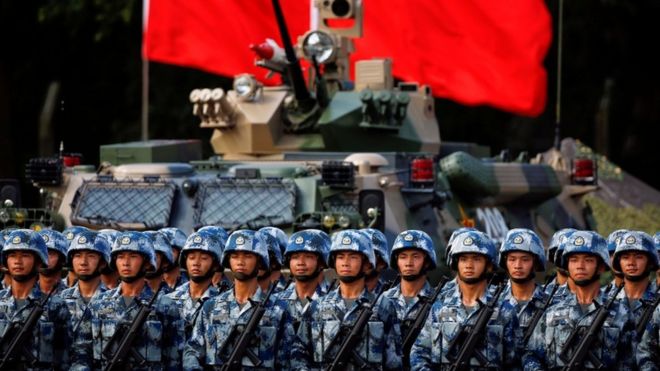Jonathan Marcus Diplomatic correspondent@Diplo1on Twitter
13 February 2018
Now, according to experts at the International Institute for Strategic Studies – the IISS – in London, it is China and no longer Russia, that increasingly provides the benchmark against which Washington judges the capability requirements for its own armed forces.
This is especially true in terms of air and naval forces – the focus of China's modernisation effort. Events in Europe mean that for the US Army, it is still largely Russian capabilities that provide the benchmark threat.
This trend has been chronicled in the Military Balance, the annual assessment of global military capabilities and defence spending, published by the IISS since 1959.
Of course the transformation of the Chinese military has been under way for some time. But now a significant way-point has been reached – or is very close – that will make it the "peer competitor" for Washington.
Ahead of the publication of this year's Military Balance later this week, I sat down with a group of IISS experts to try to tease out more of the details of this trend, providing a powerful narrative to the annual compendium's tables and statistics.
- How does China's military spending compare?
- Military facelift a sign of bigger changes
- How China is ruled: Military Affairs Commission
China's progress and technical abilities are remarkable – from ultra-long-range conventional ballistic missiles to fifth generation fighter jets. Last year the first hull of China's latest warship – the Type 55 cruiser – was put into the water. Its capabilities would give any Nato navy pause for thought.
China is working on its second aircraft carrier. It is revamping its military command structure to give genuine joint headquarters involving all the key services. In terms of artillery, air defence and land attack it has weapons that out-range anything the US can deploy.
Since the late 1990s, when it received an influx of advanced Russian technology, the Chinese Navy has recapitalised the bulk of its surface and sub-surface fleets.
China's first domestically built aircraft carrier was launched in April 2017
In the air, its new single-seat fighter, the J-20, is said by the Chinese to be in operational service.
It is what is known in the trade as a "fifth generation fighter", meaning that it incorporates stealth technology; it has a supersonic cruising speed; and highly integrated avionics.
IISS experts remain sceptical.
"The Chinese Air Force", they say, "still needs to develop suitable tactics to operate the low-observable jet and must come up with doctrines to mix these 'fifth generation' warplanes with earlier 'fourth generation models'.
"Still, China's progress is clear," they say, "you can add to these aircraft a whole range of capable air-to-air missiles that are every bit on a par with those in Western arsenals."
This year's Military Balance devotes a whole chapter to developments in Chinese and Russian air-launched weapons which they see as a key test for Western dominance.
The US and its allies have waged air campaigns since the end of the Cold War and have lost very few aircraft. But this dominance, according to the IISS, may be increasingly challenged. China, for example, is developing a very long-range air-to-air missile intended specifically to strike at tanker and command and control aircraft that now orbit out of harm's way; essential but vulnerable elements in any air operation.
The authors of the Military Balance argue that China's air-to-air missile developments by 2020, "will likely force the US and its regional allies to re-examine not only their tactics, techniques and procedures, but also the direction of their own combat-aerospace development programmes".
On land the Chinese army is lagging behind in this modernisation effort according to the IISS. Only about half of its equipment is serviceable in terms of modern combat.
But even here progress is being made. China has set a goal of 2020 as the date to achieve both "mechanisation" and what it calls "informisation". Quite what China means by this is latter term is unclear, but Beijing has been watching the developing role of information in warfare and seeking to adapt this to its own particular circumstances.


